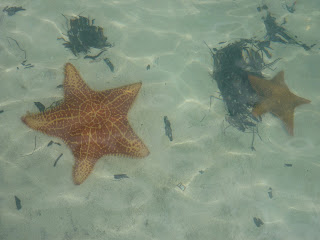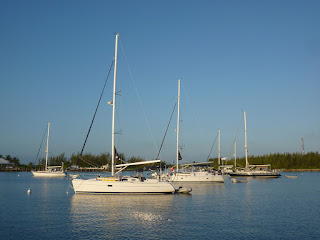We lifted anchor at 4.00 am and sounded our way through the reef out on the open ocean. The night was not very restful. The short interval of the waves did not allow for a good sleep. It was role and bumpy. In addition there were a lot of questions in regards of the upcoming crossing. The weather forecast was ok, but we knew, we would not have a smooth crossing, like when we came to the Bahamas.
We got up at 3.00 am, having a short breakfast and getting ready for the day. Turning the navigation lights on, removing the additional lanterns, we have set out, to make sure, any fisher boat could see us out on the plain water. Of course we had to put on the life vests, safety harness etc.. Finally I did check the way points again, which I have dialed in in to the navigation instruments. Agreed, it would be very hard to miss the US coast, when crossing from the Bahamas, but we did not plan for a visit at Cape Canaveral or New York...
Heading for the bow to lift the anchor was some sort of work out. The waves caused quite a bit of movement on deck. So I had to make sure, I always could get a good grip at a line, a handle or the life lines, which run from the cockpit all the way to the bow.
One we headed for the ocean, it became clear, that the waves are higher than forecasted and the wind less, than it should be. Both worked against us. The waves were about 5 feet high and it was a kind of a cross seas. The wind could help stabilize the boat, as soon as the sails are up, but it was not enough wind to really help stabilizing the boat.
So we were looking forward to a bumpy ride over the Gulf stream. Although the autopilot provides a great support, you need to be at the helm a all times. There is a lot of commercial ship traffic in the Straits of Florida and you need to pay attention to the seas and the sails. Standing at helm for 10 hours, constant movements of the boat, after a night with little sleep, can be somewhat exhausting.
The "Gugelhopf" was just fantastic!
Just about two hours, before we reached the Lake Worth Inlet, the shackle witch connects the lower end of the jib to the roller furling system became lose and the bolt fell over board. The jib started to tear. I had to respond immediately. You certainly won't have an uncontrollable flying jib, approaching a very busy inlet! I ran down to the cabin, cut a piece of rope, made my way to the bow again (which was not an easy task at sea...), and latched the jib down to fuller again. Then I made my way back to the cockpit, furling the jib, to avoid any serious damage to the sail.
Land in sight - Florida, we're coming
Finally, after just 10 hours, we reached our anchorage at Lake Worth. We called the Customs and Border Protection Office, to prepare for immigration and customs for our selfs and the vessel. We lowered the dinghy, took Bob and Sherry aboard and headed for the immigration office at Lake Worth. The process can be easy or difficult, depending on how and where the boat is documented or registered. We had a very fast and easy process, while Windsong, as a Canada documented vessel hat to apply for a cruising permit. Finally we all got our paper work done and went back to our boats, laying down for a good sleep.
Especially Bob deserved it, his autopilot failed the day before the crossing. He had to hand steer during the whole passage and did a fantastic job!
The anchorage at Lake Worth, jump off point for many cruisers



















































